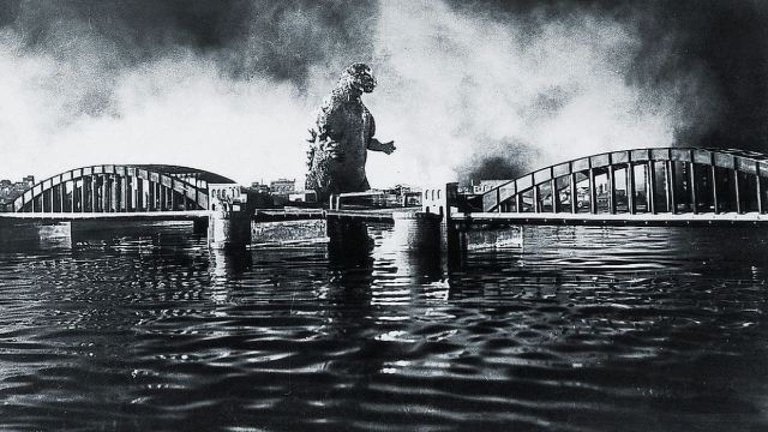Film Review: Godzilla (Gojira, 1954)

Some national cinemas have birthed their own national icons, and Japan can proudly claim Godzilla. It was introduced in eponymous 1954 science fiction disaster film (originally titled Gojira), directed by Ishiro Honda, known as the launch kaiju genre and the longest-running film series in history of cinema.
The plot begins with the crew Japanese freighter in Pacific witnessing huge underground explosion which would ultimately destroy the ship, leaving barely time for SOS signal. Ships sent to rescue mysteriously vanish, just as the fishermen at Ohto Island discover that something suddenly deprived them of fish catches. One of the elders mentions the legend about huge monster called “Gojira” coming from the sea, but nobody thinks much about it until arrival of fact-finding mission led by scientist Dr. Kyohei Yamane (played by Takashi Shimura). He discovers traces of radiation, ancient trilobite and tracks that are revealed to belong to huge 50 metres tall reptilian creature. Dr. Yamane thinks that the prehistoric-looking giant had lived in oceanic depths before US nuclear bomb tests forced it out of its natural habitat. “Gojira” begins to attack Japanese mainland, causing major destruction and loss of life, with military powerless to stop it with guns, missiles or even electric power. The only hope seems to be Oxygen Destroyer, device secretly designed by Dr. Daisuke Serizawa (played by Akihiko Hirata), Yamane’s protege, childhood friend and presumed fiance of Yamane’s daughter Emiko (played by Momoko Kochi). Unlike Emiko’s boyfriend Hideto Ogata (played by Akira Takarada), he is reluctant to use it against “Gojira” and thus reveal it to the world because, as a WW2 veteran, he is afraid that it would be copied and used as weapon as atomic bombs were.
Produced by Toho, studio that would become one of Japan cinema’s most renown institutions, simultaneously with Kurosawa’s jidai geki classic Seven Samurai, it received quite large budgets for the standards of the time. Despite its black-and-white cinematography and some rather primitive special effects like “suitmation”, or, in other words, Gojira being played by Haruo Nakajima in rubber suit, the film looked solid for the standards of its time. Honda and the producer Tomoyuki Tanaka wisely decided to Gojira almost entirely at night scenes, when the flaws of special effects won’t be that apparent.
Much of the credit for success of the films should go to Honda, whose adept direction maintains a brisk pace and effectively conveys an epic tale in just over ninety minutes. Honda, who had gained a lot of experience as assistant direction, was clearly drawing inspiration from Hollywood classics like the iconic 1933 King Kong, a film with similar subject. However, the script can be confusing, demanding some knowledge of Japan, its customs, and history. The film also has a noticeable tonal shift, with the semi-documentary start, where the disaster slowly unfolds, and the audience is still getting to know Gojira, contrasting with the latter half of the film, which has too much melodrama about Emiko being torn between Dr. Serizawa and Hideko Ogata. The weakest point of the film is the score by Akira Ifukube, which is used at inappropriate times, making the film sound disjointed and badly dated, although Ifukube should be credited for designing Godzilla's famous roar.
Honda, a WW2 veteran, was clearly inspired by traumatic events from a decade earlier, with scenes of Tokyo destruction being clearly inspired by US fire bombing of Tokyo and nuclear attacks on Hiroshima and Nagasaki. The film was inspired by the infamous Lucky Dragon No. 5 incident and fears that US nuclear bomb tests in the Pacific would have unforeseen consequences not only for Japan but for the rest of humanity. Tomoyuki Tanaka was quite open about the film being seen as a warning against the abuse of nuclear technology, and this is underlined by the final words in the film.
Although not particularly liked by the critics, Godzilla proved to be a major box-office hit, with its popularity spreading beyond Japan partly thanks to the re-edited "Americanised" 1956 version, Godzilla King of Monsters, starring Raymond Burr as American news reporter. Despite its flaws and obsolescence, the film is still powerful, especially because it is the most authentic of all Godzilla films, dealing with the issues of war and humanity's newfound ability to destroy the world, a theme sadly relevant for our times.
RATING: 6/10 (++)
Blog in Croatian https://draxblog.com
Blog in English https://draxreview.wordpress.com/
InLeo blog https://inleo.io/@drax.leo
Hiveonboard: https://hiveonboard.com?ref=drax
Rising Star game: https://www.risingstargame.com?referrer=drax
1Inch: https://1inch.exchange/#/r/0x83823d8CCB74F828148258BB4457642124b1328e
BTC donations: 1EWxiMiP6iiG9rger3NuUSd6HByaxQWafG
ETH donations: 0xB305F144323b99e6f8b1d66f5D7DE78B498C32A7
Posted using CineTV
